 Traffic is the answer!richardmasoner via flickrMeant to mention these two pieces last week, but things fell apart, as they say. (Do “they” say that, or is it just me?)
Traffic is the answer!richardmasoner via flickrMeant to mention these two pieces last week, but things fell apart, as they say. (Do “they” say that, or is it just me?)
Both relate to the connection between cars and public transportation, and both are a bit counterintuitive.
The first, an op-ed by David Owen in the Wall Street Journal, posits that traffic jams are a boon to public transportation because they piss drivers off and “turn [them] into subway riders or pedestrians” — and that congestion pricing is counterproductive because it makes driving a more pleasant (albeit expensive) experience:
Advocates of congestion-fighting strategies usually argue that traffic jams waste gasoline. That’s true, but the energy waste and carbon output attributable to idling cars is smaller than that attributable to the overall transportation network. There’s nothing green about fighting congestion if, by distributing traffic more efficiently, it results in an overall increase in traffic volume and extra miles driven by vehicles avoiding the fee areas.
I suspect squadrons of transit thinkers have plenty to say about this, but my quick reaction is this: never has a traffic jam made me want to go hop on a subway. When a traffic jam breaks, all I want to do is drive fast, and far, and reclaim the road. And I’m a fan and user of public transportation. I hope there are indeed people out there who think, “By gosh, this road sure is prone to traffic jams. I think I’ll walk next time.” But something tells me it’s not happening as often as Owen would like to think.
Or is it? Because the other piece is about parking garages in transit-oriented developments, and how more garages are being built — and in a sustainable way — so that people can drive to the train.
Parking garages have become key to the success of transit lines, developments that emphasize transit, and suburban town centers — all popular with environmental groups and others who support reduced dependence on the automobile.
Without abundant parking near transit stations in suburban areas, people won’t bother to hop on subways and trains, says Martin Stein, president of the 1,200-member National Parking Association, which is meeting near Washington, D.C., this week.
“The perception of convenience is very important,” Stein says.
So to sum up: Traffic jams are necessary to convert people to public transportation. And then cars and parking garages are necessary to make transit convenient. Partly that sounds like common sense, and partly it sounds like — well, we are just the teensiest bit addicted.


